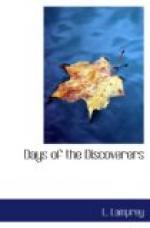There was a pleasant inlet on the coast of a bold headland, north of Cape Cod, which he thought would be his choice for his plantation. This headland he had named Cape Tragabigzanda. There were three small round islands to be seen far to seaward, which he called the Three Turks’ Heads. One Sunday, “a faire sunshining day,” he climbed a green height above Anusquam, and sitting on a huge boulder surveyed the bright and peaceful landscape and chose the site for his house. Good stone there would be in abundance, and mighty timbers that had been growing for him since the days of Noah. In this Province of New England a strong and fearless race would found new towns with the old names—Boston, Plymouth, Ipswich, Sandwich, Gloucester. So he dreamed until the sun went down under a canopy of crimson and gold, while the boat rocked in the little bay where he would have his wharf.
In 1619, when English Puritans began preparations for the founding of a new colony, he offered his services, but the older men would have none of him. He was a “Church of England Protestant” and one of the unregenerate with whom they had no fellowship. They took his map as a guide, and settled, not on Cape Tragabigzanda, which Prince Charles had re-named Cape Anne, but in the bay which he had called Plymouth. He spent some years in London writing an account of his adventures, and died in 1631 at the age of fifty-two—Captain John Smith, Admiral of New England.
NOTE
The account of Captain John Smith’s adventures among the Turks was at one time considered apocryphal, but good authorities now see no reason to regard his narrative of his own career as in any way inaccurate. The perils and strange chances which an adventurous man encountered in such times often seem almost incredible in a more peaceful age, but there is really no more reason to doubt them than to discredit authentic accounts of men like Daniel Boone, Francis Drake, or other men of similar disposition.
THE DISCOVERIES
Through tangled mysteries
of old romance
Knights, Latin,
Celt or Saxon, pass a-dream,
Seeking the minarets of magic
towers
Through the witched
woods that gleam.




